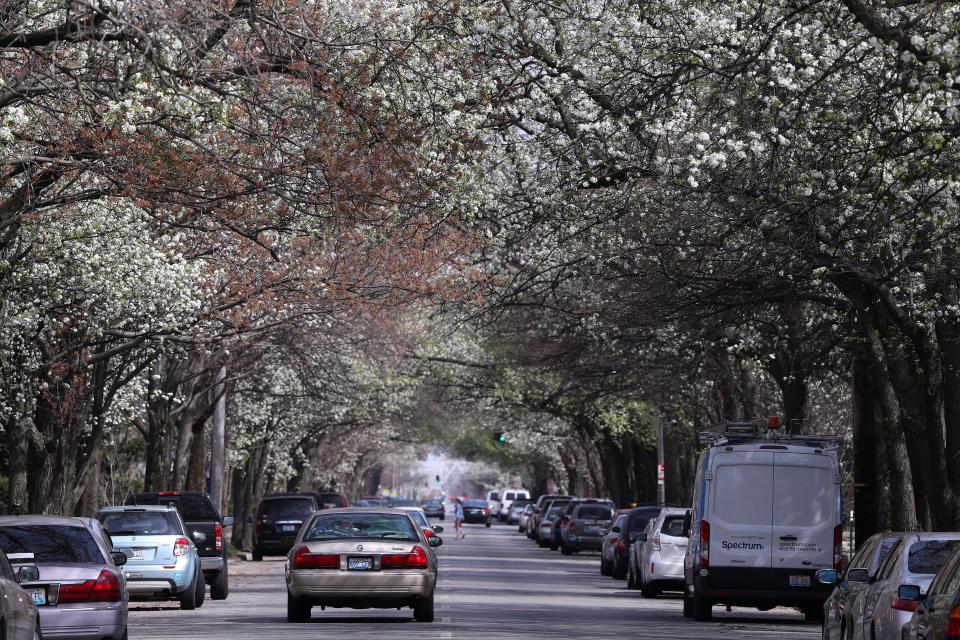Louisville's tree canopy shows growth, but some neighborhoods are falling behind

A 1% improvement in Louisville’s tree canopy over the course of a seven-year period may not seem like much.
But from TreesLouisville executive director Cindi Sullivan’s perspective, the numbers included in last week’s progress report are beyond encouraging.
“The most important thing about this new report is the comparison to the last report," Sullivan said. "The last report looked at data from 2004 to 2012, and that report documented a decline in tree canopy and also predicted a very steep decline if we didn't take action. This new report … does actually show that our efforts have not just stopped that steep decline, not just held us steady, but has increased our canopy by 1%.”
The report released late last week found Louisville's tree canopy, which measures how much of the city's land is covered by the shade provided by trees, sat at 39% as of 2019, a slight improvement from the numbers in the 2012 report. More work remains and not every part of town has seen the same progress, Sullivan said, but Louisville's tree canopy took key steps forward late in the last decade.
You may like: Kentucky Democrats move to legalize, tax marijuana, but bipartisan support is a long shot
The study was prepared by the University of Vermont Spatial Analysis Lab and TreesLouisville, a local nonprofit dedicated to improving Louisville's green scene.
The number marks a 1% improvement between 2012 and 2019, according to the survey, as trees planted more than a decade ago grew and began to contribute shade. In all, the city gained 9,591 acres of canopy, offset by 7,365 acres of loss.

Some areas around the city saw impressive improvement. For instance, the study found a 2% improvement of Louisville's street tree canopy, a typically difficult area to improve green infrastructure. Trees along city streets can lead to safer roadways, advocates have argued, as they help drivers differentiate between streets and sidewalks as well as encourage commuters to drive a little slower.
Gains in Louisville's canopy were recorded in 22 of the city's 26 Metro Council districts as well, with improvements in that seven-year period of more than 7% in four districts (3, 17, 22 and 23).

But losses were recorded in several urbanized areas around Louisville, the study found, and in other parts of town. Districts 4 and 9, which cover much of the city's Central Business District as well as Butchertown, Phoenix Hill, and some surrounding neighborhoods, saw tree canopy losses greater than 3.5%, according to the study. In District 4, which covers much of downtown, a 5% decline was reported, the worst figure in the city.
See also: Greenberg joins those critical over jail release of attempted murder suspect
It's tougher to build a better tree canopy downtown, Sullivan said, for obvious reasons – buildings, sidewalks, streets and parking lots don't provide ideal environments for a healthy greenscape. Those numbers aren't as encouraging, she said, but illustrate where progress can still be made.
"It does, I think, give us encouragement that what we need to do in order to improve those areas like the Central Business District is to create more spaces for trees to be planted, do more tree verges and tree belts in those wide sidewalks, where there's plenty of room to plant a tree between the pedestrian walkway and the roadway," she said. "There's lots of opportunity in the Central Business District to do that sort of thing."
Lesser gains were also reported in Louisville's West End, Sullivan noted, which for decades has suffered from disinvestment due to redlining and urban renewal. TreesLouisville has taken note, she said and has focused the majority of its efforts in recent years in the West End, as well as the southwest and south-central portions of the city.

Still, the numbers in the latest report are more encouraging when compared to the situation the city faced in 2012. A study published that year found Louisville's tree canopy had declined from 40% in 2004 to 37% by 2012 (that number was readjusted to 38% in the latest report after further research, Sullivan noted). That survey predicted the city's tree canopy would sit at 35% if those trends in 2012 continued.
Louisville Restaurant Week: Who's participating, what you can eat and more
Progress can still be made, but Sullivan wasn't the only one encouraged by the report. Mayor Greg Fischer said the numbers in the study show that efforts his administration put forward nearly a decade ago are paying off, including forming Sustain Louisville, a city plan to protect the local environment and reduce the city's carbon footprint.
“Creating a more sustainable Louisville has been a big part of my administration’s focus since I took office,” Fischer said. “In 2011, Louisville was struggling with a growing urban heat island. That’s why my team and I created our Sustain Louisville plan in 2013, which set goals for sustainability across our city. Now, we are moving in the right direction to meet our goal of 45% tree canopy.”
Sullivan encouraged those concerned with the environment in Louisville to act. Planting a tree, she said, can be one small step toward building a better city.
"A robust tree canopy improves air quality, manages stormwater, mitigates the urban heat island effect, provides wildlife habitats – it makes us feel better," Sullivan said. "It creates safer neighborhoods with more social cohesion."
Lucas Aulbach can be reached at laulbach@courier-journal.com, 502-582-4649 or on Twitter @LucasAulbach.
This article originally appeared on Louisville Courier Journal: Louisville tree canopy is improving. Here's what the numbers say


